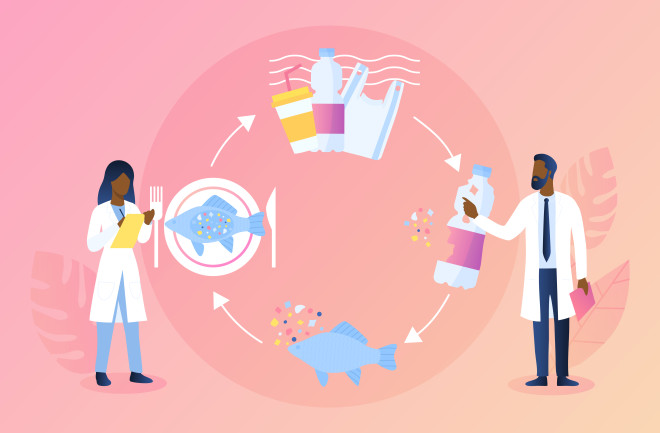Microplastics are everywhere.
Everyday items like clothing, food packaging, cosmetics and car tires shed tiny particles of plastics, which in turn find their way into blood, baby poop, placentas and breastmilk. According to recent research, plastics are even in the intricate, delicate tissue that makes up our lungs.
Research from 2019 suggests that we might breathe in up to 11.3 microplastics per hour, or up to 272 microplastics in 24 hours. And now, a new study published in the journal Physics of Fluids discovered that those plastics can get lodged into our airways and stay there over time.
“People never thought that we could inhale microplastic, so the data is underestimated and the result is more severe,” says Saidul Islam, lead author of the paper and professor at the University of Technology Sydney.
Yet, despite its ubiquity in the environment and in our bodies, scientists don’t fully understand the long-term impacts on our health.
Effects of Microplastics on the Human Body
A 2019 report published in Environmental Science & Technology found that people in the U.S. consume about 39,000 to 52,000 particles of microplastics each year through food and water. That’s the size of two giraffes in a year and the whole of the Eiffel Tower in a lifetime. According to the United Nations Environmental Program, research on the more than 13,000 chemicals associated with plastics has found that at least 3,200 of those chemicals have been shown to be hazardous to human health. Lab experiments have shown that microplastics can cause damage to human cells.
Plastic producers, such as the British Plastics Federation, have pointed to international treaties that aim to “eliminate, restrict, reduce or eliminate” persistent organic pollutants (POPs) from the environment to protect human health. In response to a recent Greenpeace report on toxic chemicals found in plastics, BPF responded that tackling plastic pollution “is essential but this cannot be done in isolation, without considering the impact of other key global environmental issues.”
Most studies tend to solely focus on the ingestion of microplastics, even though we are inhaling these plastics, too, Islam said. His study is among the first of its kind to quantify just how much we’re breathing in.
“How it is actually affecting our respiratory health is still unknown,” says Islam. Air pollution particles are known to enter the body and cause millions of early deaths a year — it's just unclear how much of that is due to microplastics.
Experts are starting to correlate microplastics with lung inflammation, shortness of breath and a higher risk of lung cancer. Research on rats suggests that when microplastics infiltrate lung cells, they can start to jumble up cell composition. This suggests that exposure to microplastics can cause lung injury in humans, too.
Similar studies suggest that polypropylene plastics — rigid materials often found in disposable containers, automobile parts and even face masks used to prevent the spread of coronavirus — damage the mitochondria inside cells, which also causes lung inflammation.
“We need more studies on how plastic embeds in the lung surface, how it act on the lung surface, how its toxicity increases over time and how it creates the diseases,” Islam said, adding that his team plans to tackle these questions in the near future. “We’re only starting to understand how it transports in the airways.”
How Many Microplastics Are in Human Lungs?
Islam ran experiments on three different microplastics shapes (spherical, tetrahedral and cylindrical) and sizes (1.6, 2.56 and 5.56 microns). He found that shape, size and breathing patterns affected where the materials ended up.
Study subjects performing vigorous physical activity, and breathing heavily, breathed in more plastics in volume than when resting. But slower breathing, associated with sleeping, was associated with smaller particles lodging deep inside the lungs.
“Usually, most of the larger microplastics deposit in the nasal cavities and trachea, because the nasal cavity acts as a filter,” says Islam. “When you’re slow breathing, smaller particles are actually dropping in the deeper areas [of the respiratory system].” Islam added that plastic nanoparticles can then move into different organs in the body.
How Disproportionately Harmful Microplastics Can Be
Research on microplastics and human health is still in its early days, said Mary Johnson, a principal research scientist at Harvard T.H. Chan School of Public Health. But one thing is clear: each stage of the life cycle of plastic disproportionately impacts vulnerable communities.
“In general, vulnerable populations are at even greater risk of the negative health impacts from the production, use and degradation of plastics,” says Johnson. She cited a 2021 United Nations report on global plastics pollution that detailed Indigenous communities’ displacement for oil extraction, contamination of water supplies in low-income communities, health problems among predominantly Black communities living near oil refineries in the South, among other dangers faced by at-risk communities.
Another study published earlier this year in Annals of Global Health found fossil-fuel workers, plastic producers and communities living near plastics production and disposal sites experienced higher rates of certain cancers, respiratory disease, and pregnancy and birth complications.
Approximately 99 percent of plastic comes from chemicals sourced from fossil fuels, and throughout their lifecycle, plastic production generates approximately 3.4 percent of global greenhouse gas emissions.
Many known human carcinogens and endocrine disruptors, such as so-called forever chemicals, are added to plastics during production to enhance performance. “Plastics are highly toxic,” says Islam. “Because when we are just inhaling the plastics, it's not only the plastic, it could also actually carry some more toxic chemicals.”
Correction: A previous version of this article erroneously stated we inhale a larger number of microplastics each hour, and misattributed the original source of this finding. This data has now been corroborated with the original researchers behind the 2019 paper.
This article is copublished with Nexus Media News and Discover Magazine. Nexus Media News is an editorially independent, nonprofit news service covering climate change. Follow us @NexusMediaNews.

